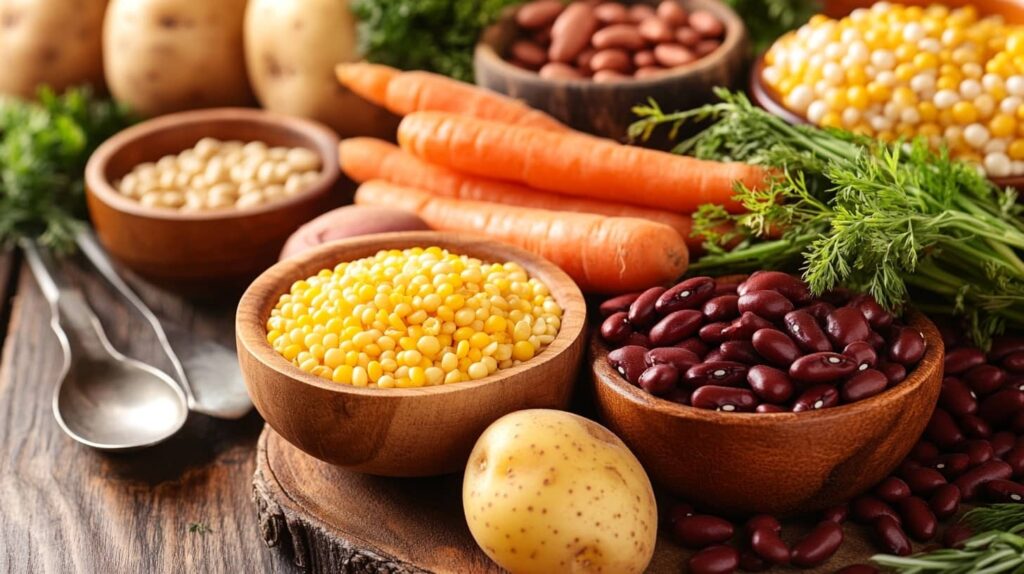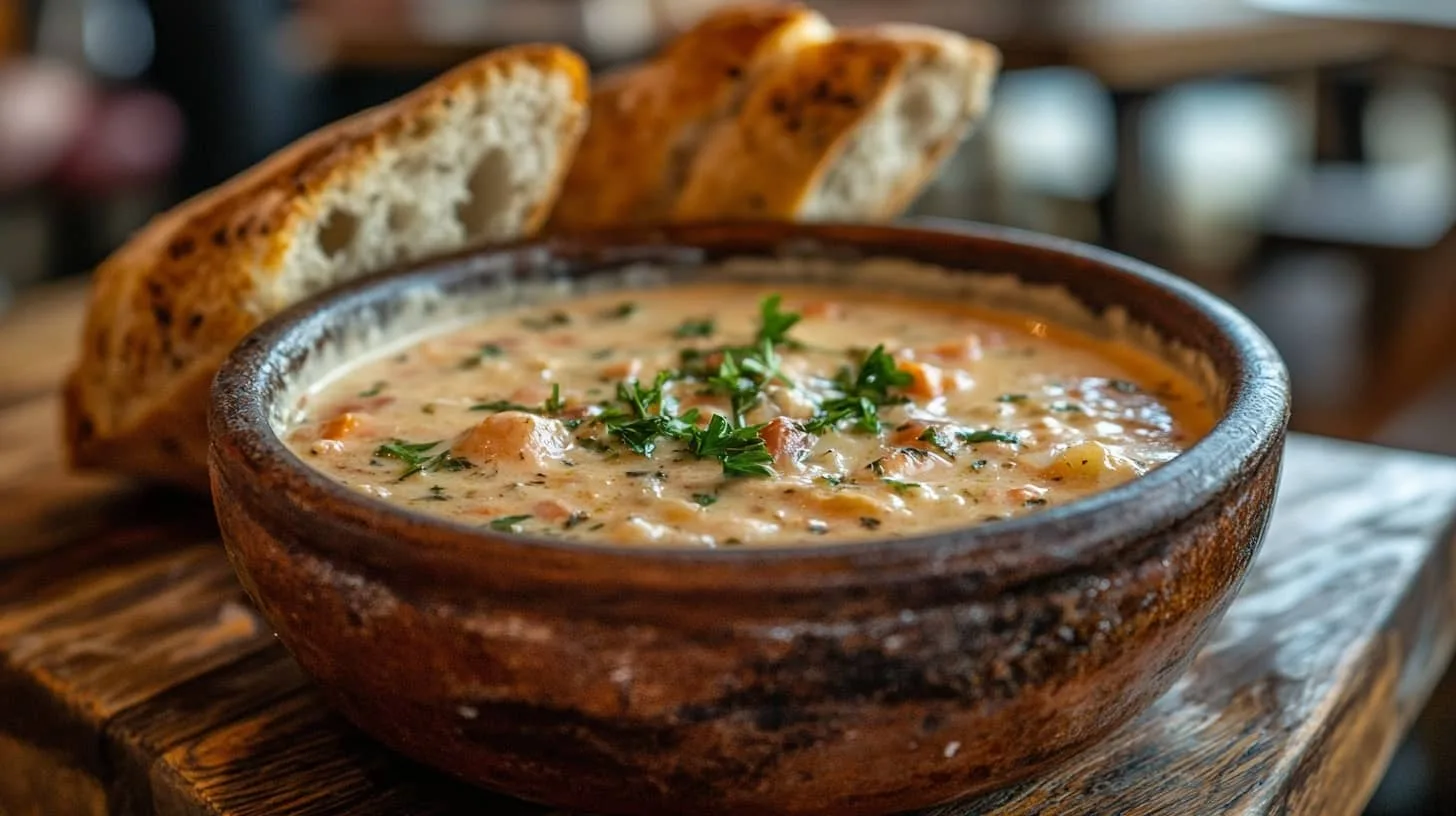What’s the Best Way to Thicken Swamp Soup?

Have you ever wondered what’s the best way to thicken swamp soup? This flavorful dish, packed with leafy greens and earthy vegetables, can sometimes end up too thin. Whether you’re cooking for family or preparing a comforting meal, finding ways to thicken soup is crucial to perfecting texture and flavor.
But how do you thicken swamp soup without ruining its taste? In this guide, we’ll share expert tips, easy soup thickening tips, and the best ingredients for thick soup to help you achieve the perfect consistency every time.
Table of contents
Introduction: Understanding Swamp Soup and Its Unique Texture
Swamp soup might sound unusual, but it’s packed with earthy flavors and nutrients. Typically made with leafy greens, root vegetables, and proteins, it has a rustic appeal that’s perfect for cozy dinners.
The challenge? Swamp soup sometimes turns out too watery. A thin, runny consistency can leave you feeling unsatisfied, like you’re sipping flavored water instead of savoring a hearty meal.
Why Do Soups End Up Thin?
There are several reasons your swamp soup might not have the desired thickness:
- Excess Liquid: Adding too much broth or water can dilute the base.
- Lack of Starches: Ingredients like potatoes, grains, or beans are natural thickeners, and without them, the soup may lack body.
- Overcooking Vegetables: Vegetables release water as they cook, which can thin out the broth.
- No Thickening Agents: Skipping flour, cornstarch, or cream can leave soups watery.
But don’t worry! We’re here to fix all of that.
Why Thickness Matters—What’s the Best Way to Thicken Swamp Soup?
Ever wondered what’s the best way to thicken swamp soup and why it’s so important? A thicker soup isn’t just about looks—it’s about flavor, texture, and satisfaction.
A thin swamp soup might taste bland and watery, leaving you disappointed. But learning how to thicken swamp soup ensures your dish is rich, filling, and visually appealing.
Top Reasons to Make Soup Thicker
- Flavor Boost: Less liquid equals concentrated flavors.
- Satisfying Texture: Thick soup feels hearty and comforting.
- Better Presentation: A rich, creamy base makes the soup look delicious.
By following these easy soup thickening tips, you’ll never have to worry about thin soups again.om.
Common Ingredients Used to Thicken Swamp Soup

Let’s explore some of the most effective ingredients for thickening soup. You probably already have many of these in your pantry or fridge!
1. Vegetables as Natural Thickeners
Vegetables not only boost nutrition but also add texture when blended or mashed:
- Potatoes: Mash or blend boiled potatoes into the soup for a starchy boost.
- Carrots: Pureed carrots add sweetness and body.
- Pumpkin or Squash: These create a creamy consistency without dairy.
- Leafy Greens: Chopped kale, spinach, or collard greens can make the soup thicker when cooked down.
2. Grains and Starches for Added Body
Grains and starches absorb liquid and create a rich texture:
- Rice: Cooked rice can be blended into the soup or added whole.
- Pasta: Adds chewiness and thickness as it absorbs liquid.
- Cornstarch: A quick fix—mix with water and stir it into the soup.
- Flour or Roux: Used in small amounts, these thicken without altering flavor.
3. Dairy and Cream Alternatives for Smoothness
Creams create a silky texture and add richness:
- Heavy Cream: A classic choice for smooth, rich soups.
- Milk or Half-and-Half: Lighter than cream but still effective.
- Coconut Milk: A dairy-free alternative that’s creamy and flavorful.
- Yogurt or Sour Cream: Adds tanginess along with thickness.
Cooking Techniques to Achieve Desired Thickness
Blending and Pureeing for Smoothness
Blending is one of the fastest ways to achieve a thicker consistency:
- Hand Blender (Immersion Blender): Blend directly in the pot for quick results.
- Regular Blender: Blend a portion of the soup and mix it back in.
- Masher or Fork: Mash vegetables right in the pot for a chunkier texture.
Quick Tip: “For the best results, blend only part of the soup. This keeps some texture while thickening the broth.”
Simmering and Reduction Methods
If you have time, let your soup simmer. The liquid will evaporate, leaving a thicker base:
- Low and Slow Cooking: Simmer uncovered to reduce water content naturally.
- Add Broth Gradually: Start with less liquid and add more only if needed.
Chef’s Secret: “Simmering also intensifies flavors, making your soup taste richer as it thickens.”
Table: Quick Reference for Ingredients and Quantities
| Ingredient | Purpose | Quantity (Per 4 Servings) |
|---|---|---|
| Potatoes | Adds starch and thickness | 2 medium, boiled and mashed |
| Cornstarch | Quick thickener | 1-2 tablespoons, mixed with water |
| Heavy Cream | Smooth and creamy texture | 1/2 cup |
| Rice or Pasta | Absorbs liquid for thickness | 1/2 cup, cooked |
| Leafy Greens (Spinach) | Fiber and bulk | 1-2 cups, chopped |
| Flour (Roux) | Classic thickening agent | 2 tablespoons flour + 2 tablespoons butter |
Best Natural Thickeners for Swamp Soup Recipes
Arrowroot and Cornstarch: Quick Fixes
Both arrowroot and cornstarch are popular because they thicken quickly and don’t alter the flavor.
- How to Use: Mix 1-2 tablespoons with cold water to create a slurry. Slowly stir it into the hot soup until it thickens.
Roux and Beurre Manié: Classic Choices
- Roux: A mixture of butter and flour cooked together before adding to soup.
- Beurre Manié: A blend of butter and flour kneaded together and stirred in at the end.
Fun Fact: “Roux is the base for sauces like béchamel, but it works wonders in soups too!”
Quick Fixes for Last-Minute Thickening

If you’re short on time and need instant results, these methods will save the day:
- Cornstarch Slurry
- Mix 1 tablespoon of cornstarch with 2 tablespoons of cold water.
- Stir it into the soup and simmer for 2-3 minutes until thickened.
- Tip: Avoid adding cornstarch directly to hot soup—it clumps!
- Mashed Potatoes
- Use leftover mashed potatoes or boil a potato, mash it, and stir it into the soup.
- This method adds thickness and creaminess without extra ingredients.
- Instant Potato Flakes
- Sprinkle 1-2 tablespoons of instant potato flakes into the soup.
- Stir well, and watch the soup thicken in seconds.
- Bonus: It adds subtle flavor too!
- Blended Vegetables
- Scoop out a cup of cooked vegetables from the soup.
- Blend them and return them to the pot.
- This not only thickens but also intensifies the flavor.
- Bread Crumbs or Crushed Crackers
- Stir in a handful of breadcrumbs or crushed crackers.
- They absorb the liquid and add texture quickly.
Adding Texture Without Compromising Flavor
If you want to keep the rustic charm of swamp soup without turning it into a puree, try these methods:
- Cooked Beans or Lentils: Blend a portion of cooked beans or lentils and mix them back in.
- Egg Yolks: Whisk 1-2 egg yolks in a bowl and slowly add some hot soup to temper them. Then stir it back into the pot.
- Cheese: Grated Parmesan or cheddar melts into the soup, adding both thickness and richness.
- Cream Cheese: Stir in a dollop for a velvety finish.
Chef’s Note: “Adding cheese or cream makes the soup luxurious—perfect for impressing guests!”
Common Problems and Challenges in Thickening Swamp Soup
Even experienced cooks sometimes face challenges when thickening soups. Let’s troubleshoot the most common problems and how to fix them.
1. Over-Thickening: How to Thin It Back Out
Oops! Did you make your soup too thick? No worries—it’s just as easy to fix.
- Add Broth or Water: Pour in a little at a time until the soup reaches the desired consistency.
- Use Milk or Cream: This lightens the texture while maintaining richness.
- Lemon Juice or Vinegar: A splash can balance flavors and thin out heavy soups.
Pro Tip: “Always thicken gradually—it’s easier to add than to take away!”
2. Avoiding Clumps and Uneven Texture
Lumpy soup can be a real letdown, but you can avoid this problem with these tips:
- Pre-Mix Starches: Always dissolve cornstarch or flour in cold water before adding it to hot soup.
- Stir Constantly: Keep stirring while adding thickeners to distribute them evenly.
- Strain Out Lumps: Use a fine-mesh sieve or blender if lumps form accidentally.
3. Maintaining Flavor Balance After Thickening
Sometimes thickening can dilute flavors. Fix this by:
- Seasoning Again: Taste and adjust salt, pepper, and spices after thickening.
- Adding Fresh Herbs: Stir in parsley, basil, or thyme for a flavor boost.
- Using Lemon or Vinegar: A splash adds brightness without overpowering.
Flavor Tip: “Fresh herbs and citrus are the secret weapons for fixing bland soups!”
Gluten-Free and Vegan Options for Thickening Swamp Soup
Looking for healthier or allergy-friendly options? These thickeners work wonders:
Plant-Based Ingredients for Vegans
- Coconut Milk or Almond Milk: Adds creaminess without dairy.
- Pureed Beans or Chickpeas: Rich in protein and fiber.
- Cashew Cream: Blend soaked cashews with water for a smooth, nutty base.
Gluten-Free Alternatives
- Arrowroot Powder: A gluten-free substitute for cornstarch.
- Tapioca Starch: Works like cornstarch but with a smoother finish.
- Mashed Cauliflower: Low-carb and creamy!
Healthy Hack: “Cauliflower is perfect for guilt-free thickness—it’s light, nutritious, and gluten-free!”
Flavor Balancing While Thickening Swamp Soup
A thick soup doesn’t have to be bland. Let’s talk about adding flavor while perfecting the texture.
Using Herbs and Spices to Enhance Flavor
- Garlic and Onion Powder: Adds depth without overpowering.
- Smoked Paprika: Gives a smoky twist, perfect for hearty soups.
- Cayenne Pepper: Adds heat if you want a spicy kick.
Avoiding Blandness After Thickening
To ensure your thick soup is as flavorful as it is rich:
- Add Bouillon Cubes: Dissolve in a little water before stirring in.
- Stir in Tomato Paste: Adds umami and richness.
- Splash of Wine: White wine can brighten flavors without overwhelming them.
Table: Quick Flavor Boosters
| Ingredient | Purpose | Amount (Per 4 Servings) |
|---|---|---|
| Fresh Garlic | Adds aroma and flavor | 2-3 cloves, minced |
| Lemon Juice | Balances flavors and brightness | 1-2 tablespoons |
| Smoked Paprika | Adds smoky richness | 1 teaspoon |
| Fresh Basil or Parsley | Enhances freshness | 1/4 cup, chopped |
| Parmesan Cheese | Adds umami and creaminess | 1/2 cup, grated |
Expert Tips for Perfecting the Consistency of Swamp Soup
Achieving the ideal consistency for swamp soup isn’t just about adding ingredients—it’s an art that involves technique, timing, and creativity. In this section, we’ll dive into expert tips and tricks to ensure your soup is always rich, hearty, and packed with flavor.

1. Start with Less Liquid
One of the simplest ways to avoid thin soup is to control your liquid from the start.
- Tip 1: Begin with less broth or water than you think you’ll need.
- Tip 2: Add more liquid gradually if required instead of pouring it all in at once.
- Tip 3: Focus on thick ingredients first—vegetables, grains, or beans—before adjusting the liquid.
“It’s easier to add liquid than to remove it. Start small, then build up!”
2. Build Layers of Flavor as You Go
Thickening isn’t just about texture—it also impacts flavor. Build flavors step-by-step while cooking:
- Sauté Aromatics: Onions, garlic, and spices bloom in oil, enhancing richness.
- Roast Vegetables First: Roasting intensifies flavors, especially with root vegetables.
- Add Broth in Stages: Simmering in smaller amounts of broth allows flavors to concentrate.
“Think of soup like a story—each ingredient adds a new chapter. Build it slowly for the best results!”
3. Let Time Work Its Magic—Simmering and Reducing
If you’re not in a rush, reducing your soup naturally thickens it while intensifying flavors.
- Low Heat, Long Time: Simmer the soup uncovered to let excess water evaporate.
- Frequent Stirring: Prevents sticking or burning as the liquid reduces.
- Taste Often: Simmering changes flavors—adjust seasoning as needed.
“Patience pays off—longer simmering creates richer soups with deeper flavors.”
4. Test the Thickness Before Serving
Before dishing out your soup, do a quick consistency check:
- Spoon Test: Scoop some soup onto a spoon and tilt it. It should coat the spoon lightly but not drip off like water.
- Dip Test: Dip a piece of bread or a cracker—if it absorbs too quickly, the soup might still be too thin.
“Don’t just eyeball it—test your soup’s thickness like a pro!”
Frequently Asked Questions About Thickening Swamp Soup
Let’s address the most common questions readers have about thickening swamp soup.
1. Can I Use Gelatin or Agar-Agar to Thicken Soup?
Yes! Both are excellent thickeners, especially if you want a jelly-like consistency or need to stabilize the soup for later storage.
- Gelatin: Dissolve in warm water and stir it into hot soup.
- Agar-Agar: Works like gelatin but is plant-based and perfect for vegans.
2. What’s the Best Way to Thicken Soup Without Changing the Taste?
For flavor-neutral thickening:
- Arrowroot Powder: Tasteless and gluten-free.
- Cornstarch Slurry: Fast and flavorless.
- Potato Flakes: Adds body without altering taste.
3. Can I Freeze Thickened Soup?
Absolutely! However, soups thickened with dairy or cornstarch may separate when thawed.
Solution:
- Freeze in small portions.
- Reheat slowly, stirring constantly to restore consistency.
“Freezing is fine—just give it a little TLC when reheating!”
4. How Do I Fix a Soup That’s Too Thick?
- Add Broth or Water: Start with 1/4 cup and increase as needed.
- Lemon Juice or Vinegar: Adds brightness and thins soup naturally.
- Milk or Cream: Lightens texture without losing richness.
5. What Are Healthy Ways to Thicken Soup?
For lighter options:
- Pureed Veggies: Sweet potatoes, carrots, and zucchini add texture and nutrients.
- Legumes: Lentils and chickpeas thicken while boosting protein.
- Greek Yogurt: Adds creaminess with fewer calories.
6. Can I Use Pasta or Rice to Thicken Soup?
Definitely! Both absorb liquid and release starch, naturally thickening soups.
- Tip: Cook grains separately and add them at the end to prevent overcooking.
“Pasta and rice do double duty—they thicken and make soup more filling!”
Explore More Delicious Recipes and Cooking Tips!
Looking for more ways to enhance your cooking skills and discover tasty dishes? Check out these helpful guides and recipes:
- The Ultimate Chicken Dumpling Soup Recipe – Learn how to make a comforting, hearty chicken dumpling soup that’s perfect for any occasion.
- Everything You Need to Know About Soup Bones – Dive into this guide on using soup bones to create flavorful broths and stocks for soups like swamp soup.
- 10 Quick Ways to Thicken Swamp Soup—Expert Tips & Hacks – Discover even more tips and tricks to make your soups thicker and tastier in no time.
- Unlock the Flavor of Swamp Soup—Simple and Stunning – Explore new ways to bring out the rich, earthy flavors of swamp soup.
These articles will take your cooking game to the next level, so don’t miss out—start exploring now! 🍲
Conclusion: Mastering the Art of Thickening Swamp Soup
So, what’s the best way to thicken swamp soup? From creamy purees to quick-fix starches, there’s no shortage of methods to achieve the perfect consistency. Whether you’re looking for gluten-free, vegan, or classic options, this guide has you covered.
- Experiment with Ingredients: Potatoes, grains, and beans are your best friends.
- Use Smart Techniques: Blending, simmering, and reduction create rich textures.
- Don’t Be Afraid to Get Creative: Cheese, yogurt, and even egg yolks can add flavor and body.
Now it’s your turn! Grab your pot and start experimenting with these tips. Soon, you’ll be serving up a bowl of swamp soup so thick and tasty, your family will be asking for seconds. 🥣







